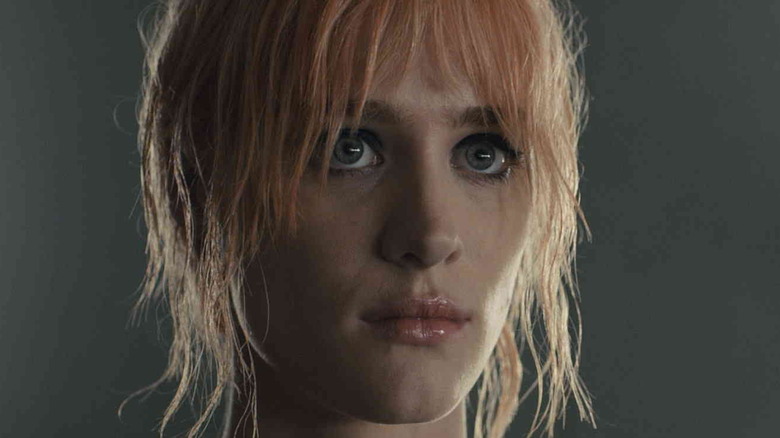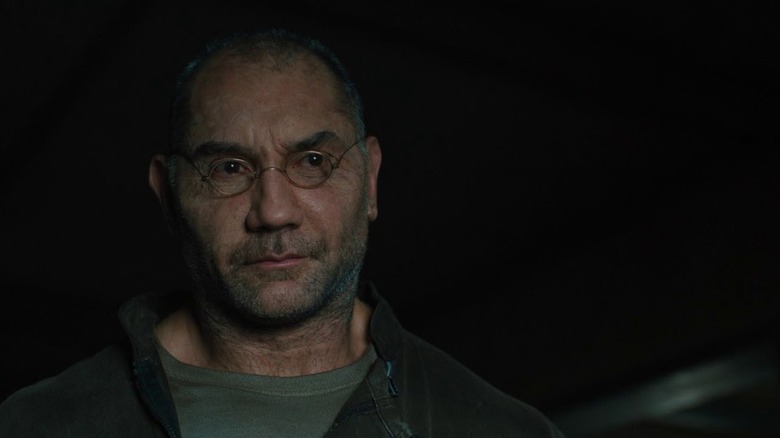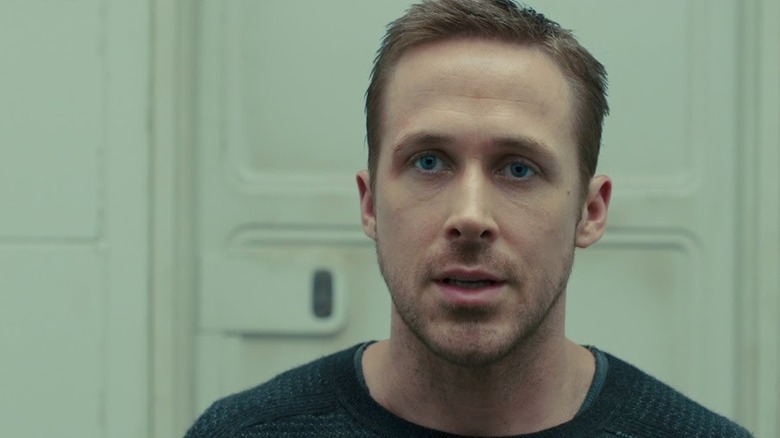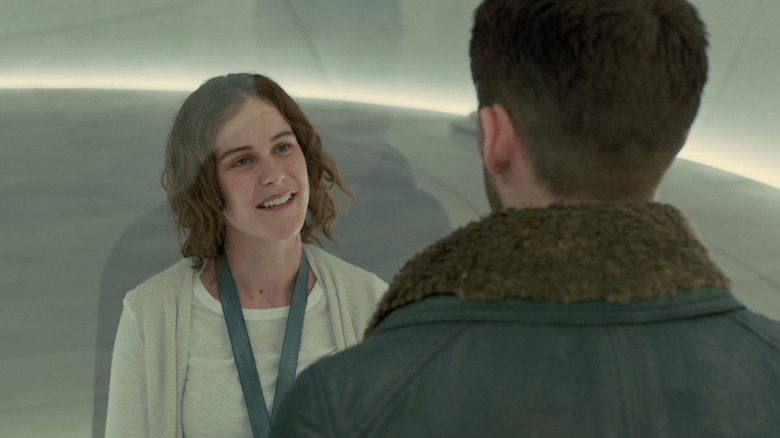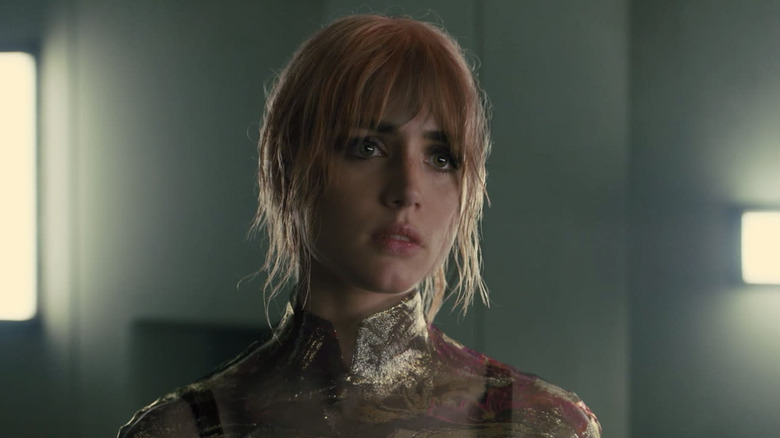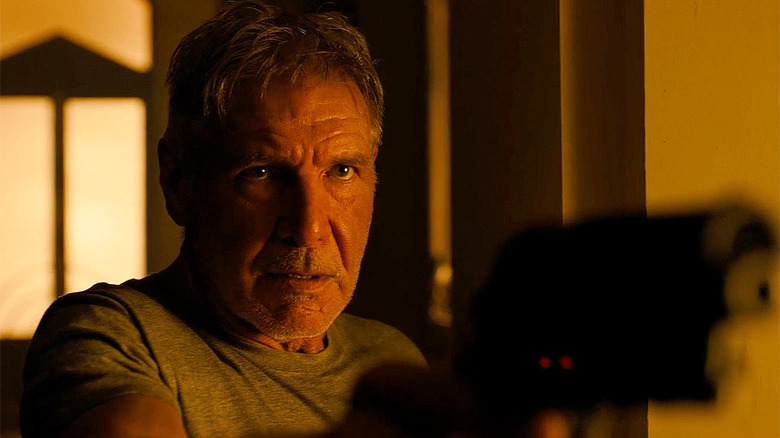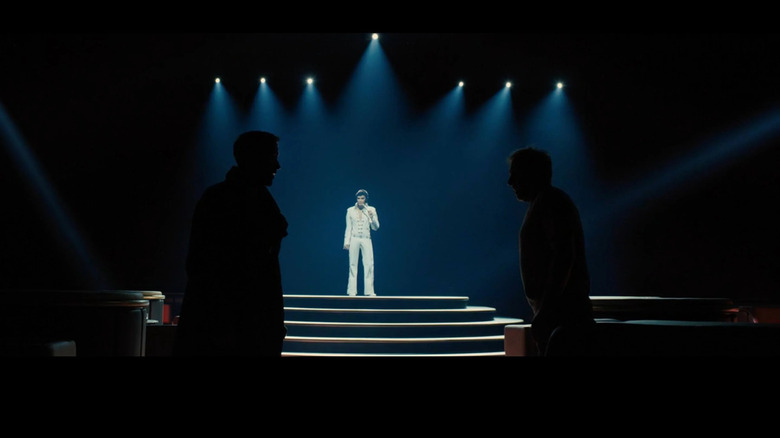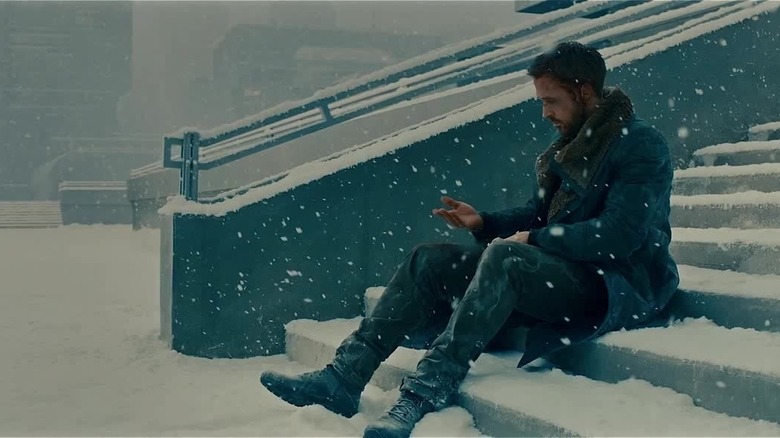Blade Runner 2049 Scenes That Deserve A Second Watch
A sequel to a film with the weighty reputation of "Blade Runner" was almost destined to fail, so the mostly glowing response to director Denis Villeneuve's "Blade Runner 2049" was a pleasant surprise to many sci-fi fans in 2017. The visionary director that went on to make "Dune" an award-winning hit teamed up with legendary cinematographer Roger Deakins to make a visually stunning and thematically challenging follow-up to 1982's cyberpunk classic. Just like its predecessor, "Blade Runner 2049" is a rich film that has plenty of scenes with deeper meanings that are worth diving into again and again.
Taking place decades after the original "Blade Runner," the sequel stars Ryan Gosling as K, a replicant Blade Runner who finds the remains of Rachael (Sean Young), which contain evidence that she had a replicant miracle child with Rick Deckard (Harrison Ford). The story follows K after he is instructed to track down and eliminate the replicant child. Along the way, the film asks questions about purpose and identity that expand on the themes of the original. "Blade Runner 2049" is a dense movie and these handful of scenes deserve a second watch to fully understand the level the film is operating on.
The Opening
After the opening text crawl of "Blade Runner 2049," Officer K arrives at the farm home of an older replicant model named Sapper Morton (Dave Bautista). This sequence moves at a slow, menacing pace as K and Sapper talk around the fact that K is a Blade Runner sent to eliminate the older model replicant. K asks Sapper to "look up and to the left," he resists, the two brawl, and before K shoots Sapper, the older model tells the officer that he's "never seen a miracle."
Dave Bautista's Sapper is only in the movie for the opening sequence, but he makes quite the impression as a gentle giant who clearly wants to live the rest of his days in peace. He is a great character to introduce Villeneuve's take on the "Blade Runner" universe, and his final line has a hidden meaning. If you watch the opening again after seeing the movie once, you'll realize the "miracle" Sapper references is the child Deckard and Rachael have together despite at least one of them being a replicant, and therefore supposedly infertile. Soon after, K discovers Rachael's remains, although it takes him a little while before he puts all the pieces of the puzzle together.
The baseline test scenes
"Blade Runner" as a universe is indebted to sci-fi and literature. The original was based on Philip K. Dick's short 1968 novel "Do Androids Dream of Electric Sheep?" But "Blade Runner 2049" also contains a handful of direct references to other pieces of literature. The most prominent of these comes during the two baseline tests K is required to take during the events of the film. All Blade Runners must continually undergo these post-traumatic tests to ensure they are fit for duty. In both instances the dialogue goes quickly enough to border on nonsensical during a first watch. Early in the movie, K passes the test; later in the movie, he fails.
In both instances, K is asked to recite and repeat passages from Vladimir Nabokov's "Pale Fire." The 1962 poetic novel also comes up when Joi (Ana de Armas) brings the book to K, asking if he wants to read it. Both works — "Do Androids Dream of Electric Sheep?" and "Pale Fire" — explore the characters' mortality, but there is a lot more ambiguity to it than that. The use of "Pale Fire" is never explained, but it has spawned a great deal of thought and writing on the connection between the novel and "Blade Runner 2049."
Stelline looks at K's memory
One of the best scenes in "2049" is a seemingly innocuous moment that ends up being the key to the whole riddle. In the middle of the film, K visits Ana Stelline (Carla Jui) at her lab. Stelline is a scientist who creates the false memories that get implanted in replicants. K goes to her to ask about a memory of his, which he believes to be real. She watches it and nearly weeps before confirming to K that the memory is indeed real.
This scene really changes when you have the context of the late movie revelation that K is not actually Deckard's child. At the time, it seems like confirmation that K is actually human and not a replicant — a subversion of the underlaying twist in the original "Blade Runner" — but later, it is revealed that Rachael gave birth to a daughter. As K eventually deduces, that daughter grew up to be Stelline, which is why she knew the memory he showed her was real and reacted to it so strongly; It was hers.
The complicated threesome scene
The primary B-plot of "Blade Runner 2049" focuses on K's relationship with his AI girlfriend, Joi. The subplot explores the boundaries of love and emotional connection without a way to physically connect. Despite this lack of literal substance, K and Joi's relationship has plenty of figurative substance and they love each other very much. This echoes the themes of replicants and other beings of artificial sentience expressing love in the story of Deckard, Rachael, and their daughter. Early in the film K meets Mariette (Mackenzie Davis), a sex worker who is later revealed to be a part of the underground replicant resistance.
In a sex scene that made a lot of waves, Joi hires Mariette to be her physical body so she and K, who she affectionally calls "Joe," can make love. In the provocative scene, Joi projects herself onto Mariette's body in an uncanny special effect. The unsettlingly brilliant CGI truly gives the feeling that there are three different people present in the scene despite the framing as an intimate encounter between a couple. This sequence echoes many of the themes explored in the 2013 movie "Her," a story set in a society where people are just beginning to date their AI OS companions.
Treasure Island
The other big mysterious literary reference in "Blade Runner 2049" comes when K breaks into Deckard's abandoned Vegas casino hideout and the two Blade Runners meet for the first time. After K finds Deckard, he steps out of the shadows, and the first line he says to K is, "You mightn't happen to have a piece of cheese about you, now? Would you, boy?" This is a quote from Robert Louis Stevenson's timeless adventure novel, "Treasure Island."
In "Treasure Island," this line of dialogue is spoken by Ben Gunn to the first man he sees after being marooned for years. The parallels to Deckard are obvious once you know this context. This small detail is also a callback to a deleted scene from the original 1982 film. In this scene, Deckard visits Holden (Morgan Paull) in the hospital after being shot by Leon (Brion James). Rick asks what Holden is reading; Holden responds by telling him it's an old favorite of his — "Treasure Island." This adds another referential layer to this scene, making it well worthy of a rewatch.
The Vegas hologram fight
One of the coolest sequences in "2049" is the initial fight between Deckard and K in the abandoned Vegas hideout. After setting off one of Deckard's traps, K stumbles into a lounge room where a malfunctioning hologram plays a projection of Elvis Presley performing on a stage. The hologram flickers between Elvis and Marilyn Monroe and back to Elvis before a gunshot rings out in the club. The ensuing combat is chaotic and lit by strobes and projections of dancers on the tables. It is incredibly dense, sometimes hard to follow, and definitely worth watching twice.
At the end of what evolves into a fist fight, Deckard says something important. While Elvis' "Can't Help Falling in Love" plays, the retired Blade Runner remarks that he likes this song. This moment is full of symbolism. Later in the movie, Niander Wallace (Jared Leto) tells Deckard he was designed for the specific purpose of falling for Rachael. To what degree Niander is telling the truth is left ambiguous, but the use of a song with that title reinforces the idea that Deckard had little choice but to go down the path of romance with Rachael, despite her limited lifespan.
K's final moments
At the end of "Blade Runner 2049," K fights to rescue Deckard from the grasp of the Wallace Corporation and becomes mortally wounded in the process. Having figured out Stelline is Deckard's daughter, he takes the old man to her laboratory. K sits down on the steps outside the clinic for one final bit of respite as the snow falls. He lays his head down and looks peacefully upwards. It's a fate that upset and confused some fans, but it is a very considered moment ... One that causes you to reevaluate the character upon rewatch.
For starters, listen and you will hear that the music that plays during K's final moments is extremely similar to the soundtrack underneath Roy Batty's (Rutger Hauer) famous "tears in the rain" dying speech at the end of the first "Blade Runner." These two moments draw a throughline between the characters. Both Roy and K ultimately save Deckard in the end of their stories and allow him to have a happy ending in each case. This ending scene is a callback to the original, as well as a parallel that emboldens "2049" as a sequel in conversation with the original.
